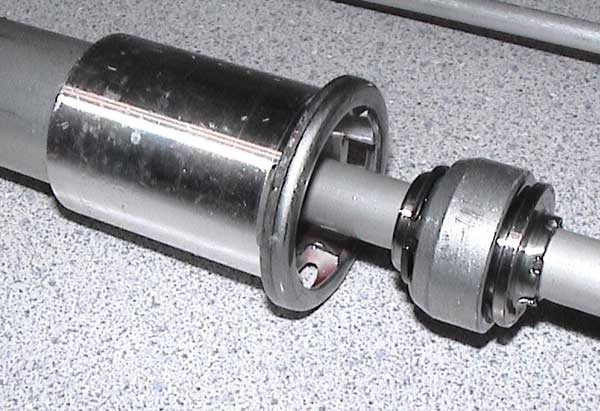
The Oil Lock Piece
In most forks, the oil lock is the only part of the damping system that is position sensive rather than speed sensitive. The oil lock piece sits at the bottom of the fork or on the damper rod and alters the compression damping when the fork reaches the last 10 mm of travel or so. A volume of oil is captured by it and must be forced through the gap made by the stanchion and the lock piece or the pressure tube and lock peice, similar to a low speed valve. This circuit overrides all other compression damping, and the other circuits function only when the lock piece allows the fork to move. Revalving or reshaping the piece can open up these last few mm of travel to function on the low/high speed damping curve. These cost $13.50 each to replace, so you shouldn't have to worry too much about mangling them up. Most tuners will just remove them for racers or educated street riders.
Some tuning companies will replace or modify them to eliminate their effectiveness. This is usually done for track bikes that do not see the same type of square shaped hits that a street bike will. Since 10mm at the last part of travel is quite a bit, the importance of this modification to the racer should not be missed.
Drilling a single 1-2mm hole through the sleve right at the base may be a good starting point. You may have to increase this size. I am just suggesting this as it will still damp, but at a higher speed.
Springs or elastomers are sometimes used instead of the hydraulic system I describe. In theory this is not a very good idea. These systems will introduce forces that the system is not designed to control. Controlling the motion of the system is the purpose of damping, not springs. Springs are used to suspend the vehicle. Top out springs are employed as a cheap and effective way of stopping the fork from slamming at the extention side of traves, but that is not a situation that truely affects overall bike handleing.

If you do fully disassemble the fork to modify or remove the Oil Lock Piece, and your fork lacks an easy way to drain oil from the bottom.,this is a great time to install a threaded drain hole in the back side of the bottom of the fork. With this in place, oil can be quickly drained and changed while the fork is fully installed on the bike. All you need to know to do this is the exact volume of oil that the fork takes after completing the oil height adjustment.
This site has not been
updated since Fall 2006.
Since then, all new projects
have been place on my wiki
site.
If you like what you see on
this site, Make sure to go
to the wiki for even better
projects.